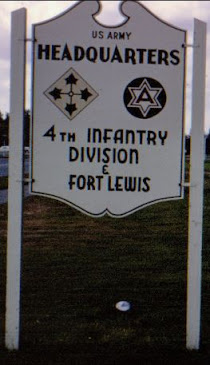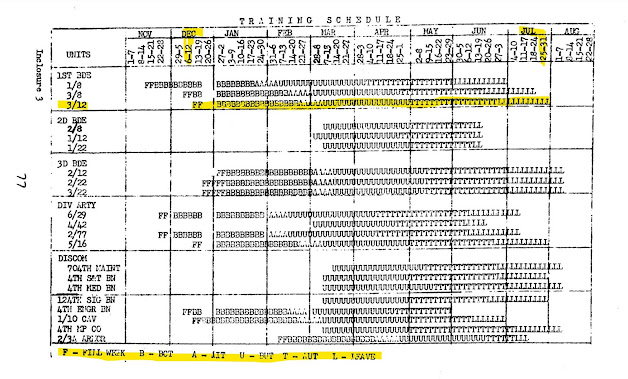
FORMATION, TRAINING AND DEPLOYMENT
In 1965, the conflict in Vietnam, once limited in scope, involving mainly United States military advisors to the military of the Republic of South Vietnam, blossomed into a full scale ground war. US Marine and US Army combat divisions arrived, oriented themselves to this strange new conflict, and began conducting offensive operations throughout South Vietnam.
On November 1st, 1965, the 3rd Battalion, 12th Infantry Regiment (3-12) was activated at Fort Lewis, Washington, and joined her sister battalions (1-12 and 2-12) as a member of the “Famous Fighting Fourth” 4th Infantry Division. Bravo Company was the first active Company in the Battalion, and it’s morning report for November 1st, 1965 lists it’s Company Commander as First Lieutenant Kasprisin, who was also the sole officer in the company. Under his command was one enlisted man, a Specialist Fourth Class mortarman named Glenn Ruschhaupt. From these inauspicious beginnings would rise a battalion that would become the only battalion of the five in the 12th Infantry regiment to be awarded not one, but two Presidential Unit Citations.
For the next three months, the battalion would gain the men and materials it needed to begin its training, which would begin in earnest in January of 1966. As part of the 1st Brigade, 4th Infantry Division, the “Braves” of 3-12 Infantry would train for the next 10 months before being deployed to the Republic of Vietnam. During this time, the battalion participated in four field training exercises, conducted Basic and Advanced Individual Training for new recruits (both draftees and enlistees) and Basic and Advanced Unit Training. Multiple infantry battalions of the 4th Infantry Division were being trained concurrently in the same manner. The 3-12 occupied a set of drab yellow World War II era barracks. Confined to the immediate area and stuck in uniform during the initial phases of training, they eventually earned privileges like off post passes and civilian clothes. In June of 1966, the “Braves” were alerted for overseas movement, and began packing equipment, conducting final training and preparing themselves for the journey that awaited them. Once the majority of their gear was ready for the long journey overseas, they were granted 2-weeks leave in August. Alpha Company’s Billy Lomnicki, Al McMullan and Joe Rando, along with many others, packed into an east coast bound United Airlines Boeing 720 and prepared for their last taste of freedom for a while. For two weeks the young men of the 3-12 did what young men headed to war often do, and once their leave days were over, reluctantly filtered back to Ft. Lewis.

September of 1966 found the 3-12 Infantry as a fully functioning infantry battalion, consisting of Headquarters, Alpha, Bravo and Charlie Companies. With an authorized strength of 789 officers and enlisted men, the 3d Battalion, 12th Infantry was led by Lieutenant Colonel (LTC) David Peters, a 1946 graduate of the U.S. Military Academy at West Point. He had commanded the battalion during the training period in 1966, and would be the first battalion commander to lead troops of the 3-12 Infantry into battle. LTC Peters was also a decorated veteran of the Korean War, and had previously served a tour in Vietnam with the US Special Forces.
On September 7th, 1966, the advanced party (HHC(-) and B Co and elements of C Co) staged at Ft. Lewis and manifested for their short ride to nearby McChord Air Force Base. Ernie Conner, sitting on the barracks steps at Lewis, heard the sound of a massive explosion echo across the military base. A C-141 Starlifter on the tarmac at McChord, while undergoing routine maintenance, had suffered a catastrophic fuel vapor explosion in a nearly empty fuel tank on the right wing of the aircraft. Three Air Force maintenance crewmen were killed in the explosion.
The men from HHC and B Co were brought to the flight-line, where they boarded another C-141 Starlifter for the long flight. As if departing to a war zone wasn’t sobering enough, taxing past the still smoldering remains of the destroyed Starlifter surely dampened the mood even further. Upon takeoff, the giant aircraft turned west over the Pacific Ocean. Final Destination – Tuy Hoa, Vietnam.
Charlie Company, commanded by Captain Brian Carroll, ended up split into several elements. Some boarded C-141 Starlifters, and strapped themselves into rear-facing nylon seats on aluminum frames. Departing McChord Air Force Base, the giant silver jets roared into the sky and headed west to Wake Island, where they landed and refueled. Next stop was Clark Air Force base in the Philippines, where they stayed overnight. One more quick flight brought them into the Republic of Vietnam, where they joined the rest of the battalion in Tuy Hoa.
For other Charlie Company soldiers, along with the rest of HHC and Alpha Company, the voyage would occur by means of a much slower mode of transportation.
sources
“Led by Love of Country” History of the 3/12 – military record
Various posts and quotes pulled from 3-12 Infantry Vietnam Veterans Facebook Group
Obituary of LTC David Peters : https://obits.staradvertiser.com/2012/12/12/david-m-peters/
C-141 accident report – https://www.baaa-acro.com/crash/ground-explosion-lockheed-c-141a-lm-starlifter-mcchord-afb-3-killed